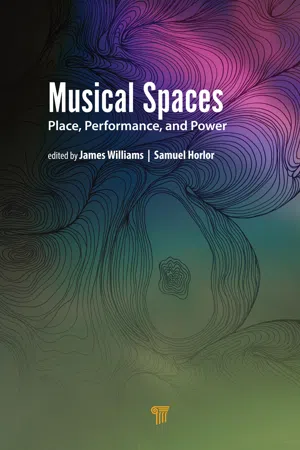1.1 Introduction
In researching music and regional identity in Minas Gerais, Brazil, I engage three interrelated notions of musical space: the geography of cultural territory’s physical places; the spaces of social development within and between historical communities; and the spaces of consciousness hosting identities of place as emotional, cognitive experiences enabling what some have theorized as neuro-phenomenological ‘enactment’ (Schiavio, 2014). This chapter focuses on applying theories of musical spaces while briefly engaging other important aspects of three case studies illustrating the defining role these spaces play in considering what I term ‘deep regionalism’. These musical spaces, equated with the places of self and social identities, frame the music depicted here with notions of empowerment: individual, social, historical, and political. The three select case studies in Minas Gerais are: the Congado popular Catholic processional of contemporary African-descendant communities in the city of Ouro Preto; the ten-string Brazilian guitar (viola or viola caipira), an instrument/object of regional iconicity; and lyrics extolling pathos of regional place and history in songs from the region’s Corner Club popular music collective (Clube da Esquina). Each case study engages the array of musical spaces in unique ways.1
1.2 Musical Space in Consciousness
Ouro Preto’s culturally symbolic physical locations, and the historical arenas of the Reinado’s figurative spatialities of confrontation, are near-empty ideas without the participatory consciousness in which individuals enact identity of place as a cognitive musical experience in real time, mapping in some way to these meanings. ‘Musical sense-making is not a passive representation of elements of the musical environment. Rather, it is a process of bringing forth, or enacting, a subject’s own domain of meaning’ (Schiavio, 2014: 142). Intentionality and purposefulness on the part of Congado participants (performers, audience, and community members), as a musical space, form a key element to deep regionalism, an identity of place made real by neuro-phenomenological enactment. Similar neuro-phenomenological processes hold true, as key to meaningfulness, in the following descriptions of the viola as an icon of Minas’ rural past and of regionalist themes in the music of the Clube da Esquina popular music collective. If we are to say that these examples offer potential for deep regionalism, then we are saying that participants cognitively enact such sentiments, positioning themselves towards identities of place through music. Aesthetic and formal realms attract and encourage such participation through style, sound, and structures.
Music is neither expressive nor symbolic without participants consciously enacting experiential meaningfulness of those expressions and symbols. Enactment leads to processual, musical spaces of consciousness hosting identities of place. Here, I theoretically concretize cognitive experience as being elemental to deep regionalism; through performer and audience enactment of meaningfulness, music enables mindful engagement of both the objective physicality of cultural territory and the discursive arenas of historical social implications. Sense-making brought about in musical encounters is, furthermore, socially conditioned and linked to expectations inherent in broader experiences with the world. Theories of ‘embodiment’ suggest how affective encounters made beautiful, powerful, and sensual by music augment and facilitate the formation of identities of place enhanced by physical places and historical space. Notions of embodiment locate regionalism within a participant’s sense-making of experiential meaningfulness with music. In the twenty-first-century ethnomusicological literature, embodiment acquires interrelated meanings (Ciucci, 2012; Gibson and Dunbar-Hall, 2000; Guy, 2009; Magowan and Wrazen, 2013; Schultz, 2002). I draw from across these sources to form a threefold neuro-phenomenological concept of embodiment, emplacement, and emplotment: in lifting ourselves up into music (enacting), we place ourselves into relationships with geographies of cultural territories and into narratives of music’s ‘formative spatialities’ (after Leyshon, Matless, and Revill, 1995: 424–425) of social developm...
